Analysis and Application of the Sliding Mode Control Approach in the Variable-Wind Speed Conversion System for the Utility of Grid Connection
Abstract
:1. Introduction
2. System Description
2.1. Modeling of Wind Generation System
2.2. Permanent Magnet Synchronous Generator Model
2.3. The Equivalent Circuit and Model of the Converter Connected to the Grid
3. Proposed Sliding Mode Control Approach
3.1. The Principle of the Sliding Mode Control Approach
3.2. Sliding Surface
3.3. SMC Law
3.4. Proof of the Stability
4. Low Voltage Ride Through
4.1. The Voltage Quality
4.2. Hold the Frequency and Voltage
4.3. Rapid Voltage Variation
4.4. The Hold of Reactive Current
- The time period for the injection or absorption of the reactive current must be within the minimum fault clearing time; this period is equal to 60 ms.
- The difference between the voltage obtained before disturbance and that provided after it is as follows: .
- Or Un: is a permissible rated voltage.
- The difference between the current obtained before the disturbance and that provided after it is: .
4.5. Fault Mode
- if Pg_ref = Pref → no loss at the line;
- if Pgref < Pref → a fault that must be compensated for the voltage.
5. Simulation and Experimental Results
5.1. Case I: Simulation and Experimental Results of the Wind Turbine under SMC-DPC-SVM Control of the Machine Side Converter
5.2. Case II: Simulation and Experimental Results Provided by the Grid Side Converter Using the SMC-DPC-SVM Approach
5.3. Case III: Study of the LVRT in the Tunisian Grid Code
6. Conclusions
Acknowledgments
Author Contributions
Conflicts of Interest
References
- Zoghlami, M.; Kharoui, R.; Fnaeich, N.; Bacha, F. Direct Power Control Strategy for Variable Speed Wind Energy Conversion System Based on PMSM Generator. In Proceedings of the International Symposium on Power Electronics, Electrical Drives, Automation and Motion (SPEEDAM 2016), Anacapri, Italy, 22–24 June 2016. [Google Scholar]
- Orlando, N.A.; Liserre, M.; Mastromauro, R.A.; Dell Aquila, A. A survery of control issues in PMSG-based small wind-turbine systems. IEEE Trans. Ind. Inform. 2013, 9, 1211–1221. [Google Scholar] [CrossRef]
- Galadi, V.; Piccolo, A.; Siano, A. Designing an adaptive fuzzy controller for maximum wind energy extraction. IEEE Trans. Energy Convers. 2008, 23, 559–569. [Google Scholar] [CrossRef]
- Giraldo, E.; Garces, A. An adptive control strategy for a wind energy conversion system based on a PWM-CSC and PMSG. IEEE Trans. Power Syst. 2014, 29, 1446–1453. [Google Scholar] [CrossRef]
- Howlader, A.; Urasaki, N.; Yona, A.; Senjyu, T.; Saber, A. Design and Implement a Digital H∞ Robust Controller for a MW-Class PMSG-Based Grid-Interactive Wind Energy Conversion System. Energies 2013, 6, 2084–2109. [Google Scholar] [CrossRef]
- Vu, N.T.; Yu, D.Y.; Choi, H.H.; Jung, J.W. TS Fuzzy-Model-Based Sliding-Mode Control for Surface-Mounted Permanent-Magnet Synchronous Motors Considering Uncertainties. IEEE Trans. Ind. Electron. 2013, 60, 4281–4291. [Google Scholar] [CrossRef]
- Zoghlami, M.; Bacha, F. Implementation of Different Strategies of Direct Power Control. In Proceedings of the 6th International Renewable Energy Congress (IREC 2015), Sousse, Tunisia, 24–26 March 2015. [Google Scholar]
- Yassin, H.M.; Hanafy, H.H.; Hallouda, M.M. Enhancement low-voltage ride through capability of permanent magnet synchronous generator-based wind turbines using interval type-2 fuzzy control. IET Renew. Power Gener. 2016, 10, 339–348. [Google Scholar] [CrossRef]
- Conroy, J.F.; Watson, R. Low-voltage ride-through of a full converter wind turbine with permanent magnet generator. IET Renew. Power Gener. 2007, 1, 182–189. [Google Scholar] [CrossRef]
- Justo, J.J.; Bansal, R.C. Parallel R-L configuration crowbar with series R-L circuit protection for LVRT strategy of DFIG under transient-state. Electr. Power Syst. Res. 2018, 154, 299–310. [Google Scholar] [CrossRef]
- Saadat, N.; Choi, S.S.; Vilathgamuwa, D.M.A. Statistical evaluation of the capability of distributed renewable generator-energy-storage system in providing load low-voltage ride-through. IEEE Trans. Power 2015, 30, 1128–1136. [Google Scholar] [CrossRef]
- Shi, L.; Chen, N.; Lu, Q. Dynamic Characteristic Analysis of Doubly-fed Induction Generator Low Voltage Ride-through. Energy Procedia 2012, 16, 1526. [Google Scholar] [CrossRef]
- Wu, Z.; Dou, X.; Chu, J.; Hu, M. Operation and Control of a Direct-Driven PMSG-Based Wind Turbine System with an Auxiliary Parallel Grid-Side Converter. Energies 2013, 6, 3405–3421. [Google Scholar] [CrossRef]
- Saad, N.H.; Sattar, A.A.; Mansour, A.M. Low voltage ride through of doubly-fed induction generator connected to the grid using sliding mode control strategy. Renew. Energy 2015, 80, 583–594. [Google Scholar] [CrossRef]
- Zeng, B.; Zou, J.X.; Li, K.; Xin, X.S. A novel sliding mode control based low voltage ride through strategy for wind turbine. In Applied Mechanics and Materials; Trans Tech Publications: Zürich, Switzerland, 2014; Volume 548–549, pp. 890–894. [Google Scholar]
- Zhuo, G.; Hostettler, J.D.; Gu, P.; Wang, X. Robust Sliding Mode Control of Permanent Magnet Synchronous Generator Based Wind Energy Conversion Systems. Sustainability 2016, 8, 1265. [Google Scholar] [CrossRef]
- Alizadeh, O.; Yazdani, A. A Strategy for Real Power Control in a Direct-Drive PMSG-Based Wind Energy Conversion System. IEEE Trans. Power Deliv. 2013, 28, 1297–1305. [Google Scholar] [CrossRef]
- Yaramasu, V.; Wu, B.; Rivera, M.; Rodriguez, J. A new power conversion system for megawatt pmsg wind turbines using four-level converters and a simple control scheme based on two-step model predictive strategy—Part II: Simulation and experimental analysis. IEEE J. Emerg. Sel. Top. Power Electron. 2014, 2, 14–25. [Google Scholar] [CrossRef]
- Teninge, A.; Roye, D.; Bacha, S. Reactive Power Control for Variable Speed Wind Turbines to Low Voltage Ride through Grid Code Compliance. In Proceedings of the XIX International Conference on Electrical Machines (ICEM 2010), Rome, Italy, 6–8 September 2010. [Google Scholar]
- Zhang, X.; Wu, Z.; Hu, M.; Li, X.; Lv, G. Coordinated Control Strategies of VSC-HVDC-Based Wind Power Systems for Low Voltage Ride Through. Energies 2015, 8, 7224–7242. [Google Scholar] [CrossRef]
- Cárdenas, R.; Díaz, M.; Rojas, F.; Clare, J.; Wheeler, P. Resonant control system for low-voltage ride-through in wind energy conversion systems. IET Power Electron. 2016, 9, 1297–1305. [Google Scholar] [CrossRef]
- Magesh, M.; Sundareswaran, R. PMSG Based Wind Energy Conversion with Space Vector Modulation. Int. J. Energy Power Eng. 2015, 4, 146–152. [Google Scholar] [CrossRef]
- Teninge, A.; Jecu, C.; Roye, D.; bacha, S.; Duval, J.; Belhomme, R. Contrubution to frequency control through wind turbine inertial energy storage. IET Renew. Power Gener. 2009, 3, 358–370. [Google Scholar] [CrossRef]
- Merzoug, M.; Benall, H.; Louze, L. Sliding Mode Control (SMC) of Permanent Magnet Syncronous Generators (PMSG). Energy Procedia 2012, 18, 43–52. [Google Scholar] [CrossRef]
- Errami, Y.; Ouassaid, M.; Cherkaoui, M.; Maaroufi, M. Variable Structure Sliding Mode Control and Direct Torque Control of Wind Power Generation System Based on the PM Synchronous Genrator. J. Electr. Eng. 2015, 66, 121–131. [Google Scholar]
- Karoui, R.; Zoghlami, M.; Bacha, F. Impact of the STATCOM on the Terminal Voltage of a Wind Farm of Bizerte in Tunisia. In Proceedings of the 2016 7th International Renewable Energy Congress (IREC), Hammamet, Tunisia, 22–24 March 2016. [Google Scholar]
- Karoui, R.; Aouiti, A.; Zoghlami, M.; Bacha, F. Impact of static synchronous compensator on the stability of a wind farm: Case study of wind farm in Tunisia. Wind Eng. 2016, 40, 555–568. [Google Scholar] [CrossRef]
- Zhong, C.; Wei, L.; Yan, G. Low Voltage Ride-through Scheme of the PMSG Wind Power System Based on Coordinated Instantaneous Active Power Control. Energie 2017, 10, 995. [Google Scholar] [CrossRef]
- Abdelrahem, M.; Kennel, R. Fault-Ride through Strategy for Permanent-Magnet Synchronous Generators in Variable-Speed Wind Turbines. Energies 2016, 9, 1066. [Google Scholar] [CrossRef]
- Decree of December 2016 Relating to the Technical Requirements of Connection and Evacuation of the Energy Produced from Renewable Energy Installations on the Low Voltage Network. 2017. Available online: http://www.legislation.tn/fr/detailtexte/Arr%C3%AAt%C3%A9-num-2017-0394-du-09-02-2017-jort-2017-013__20170130X3944 (accessed on 26 January 2018).
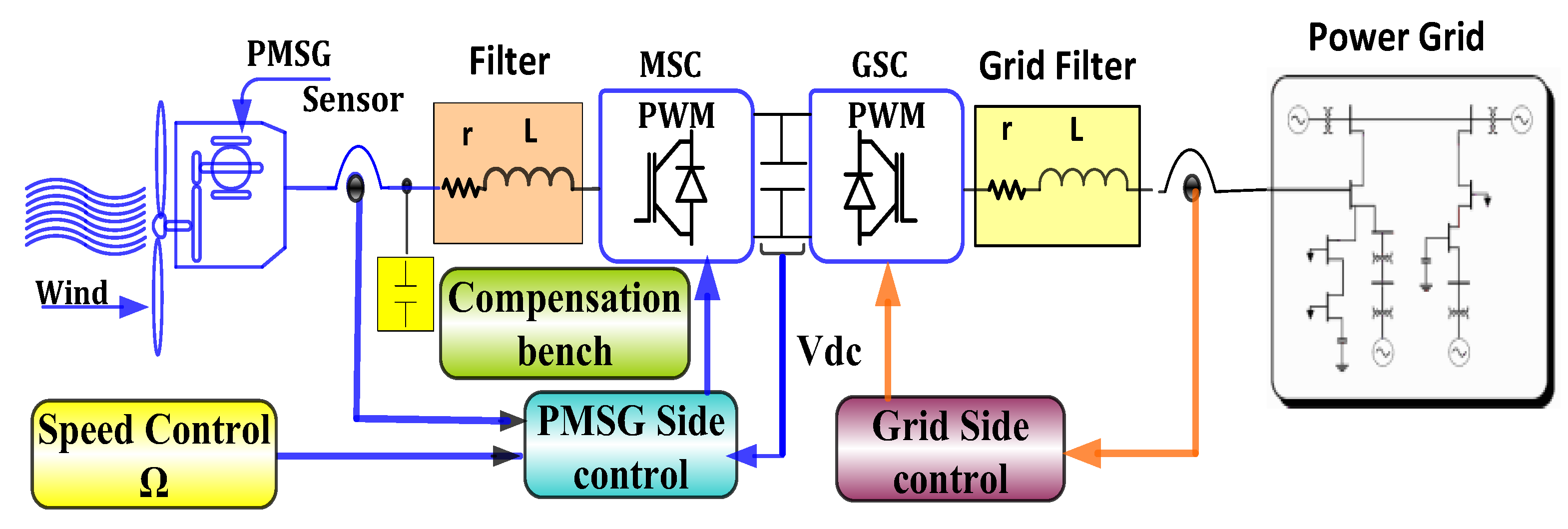
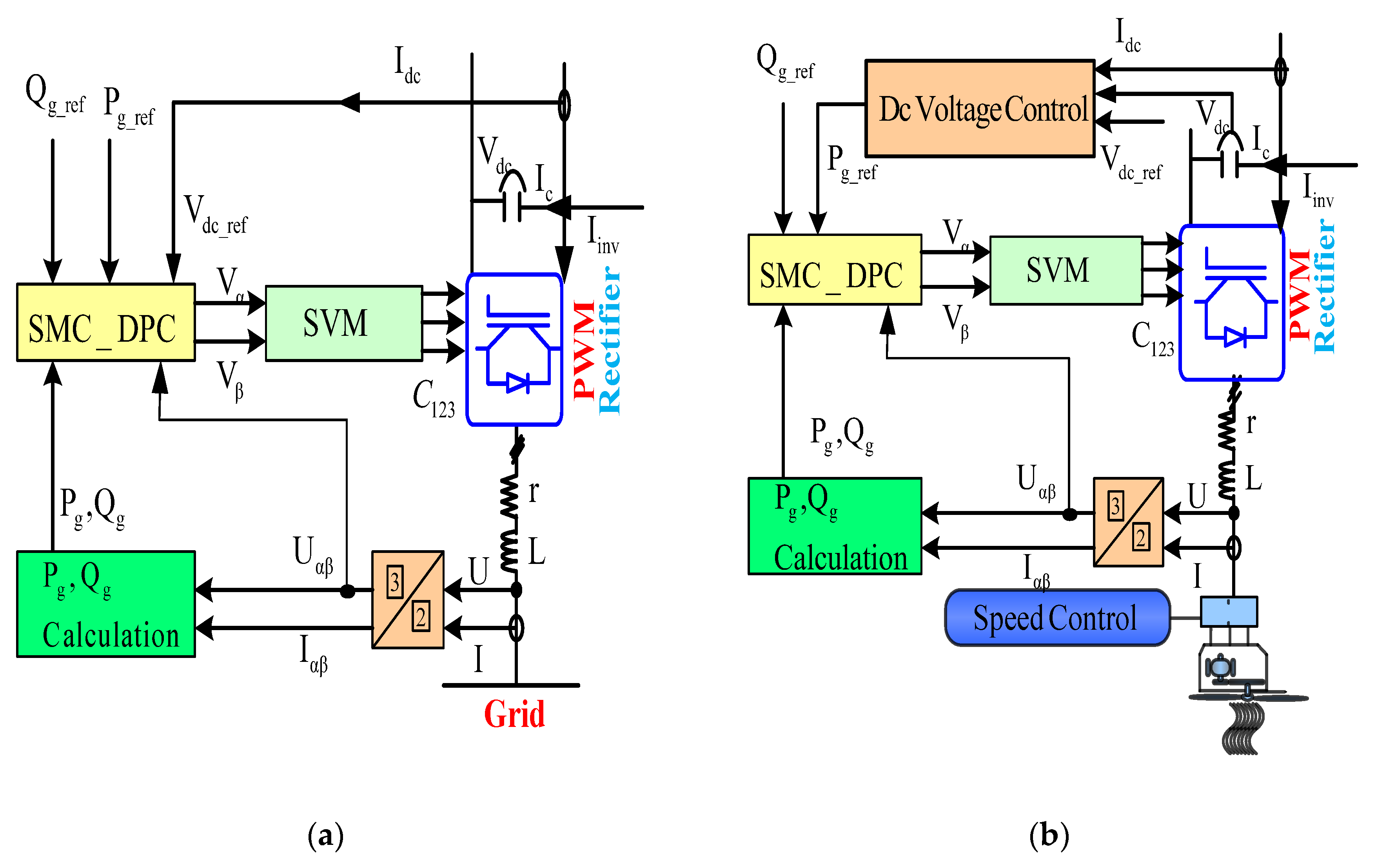
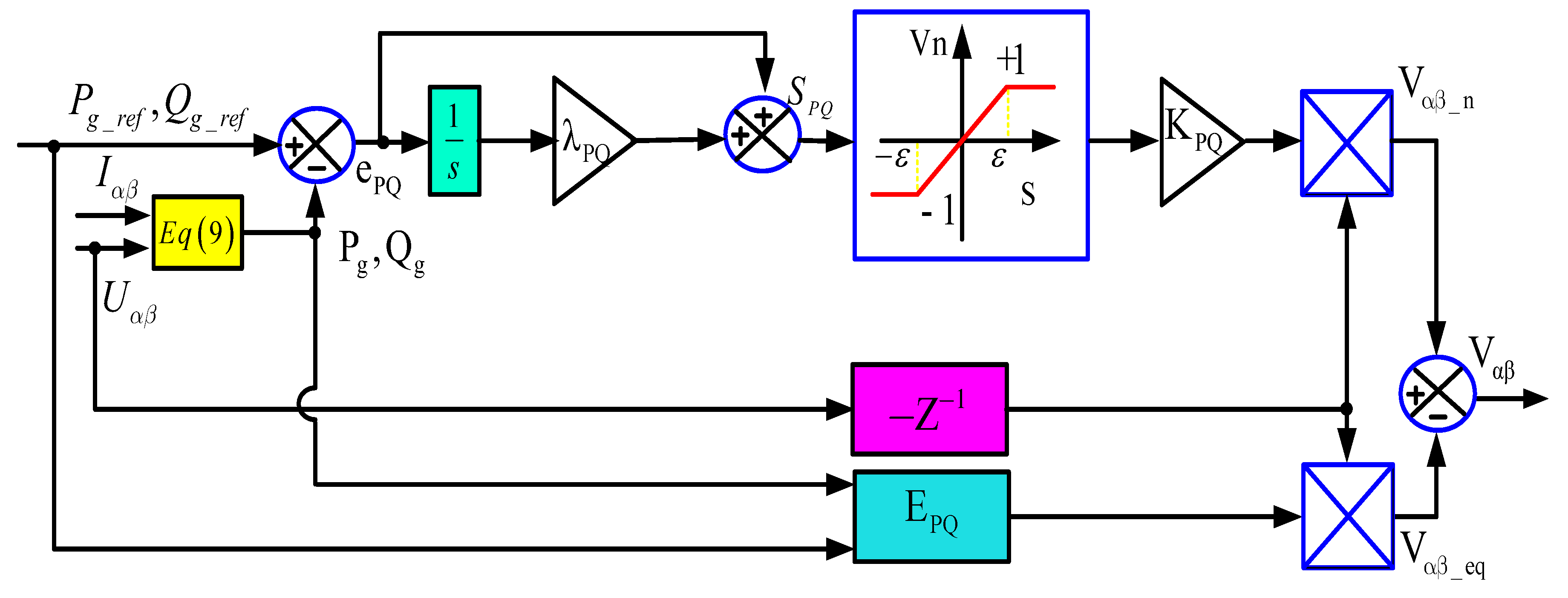
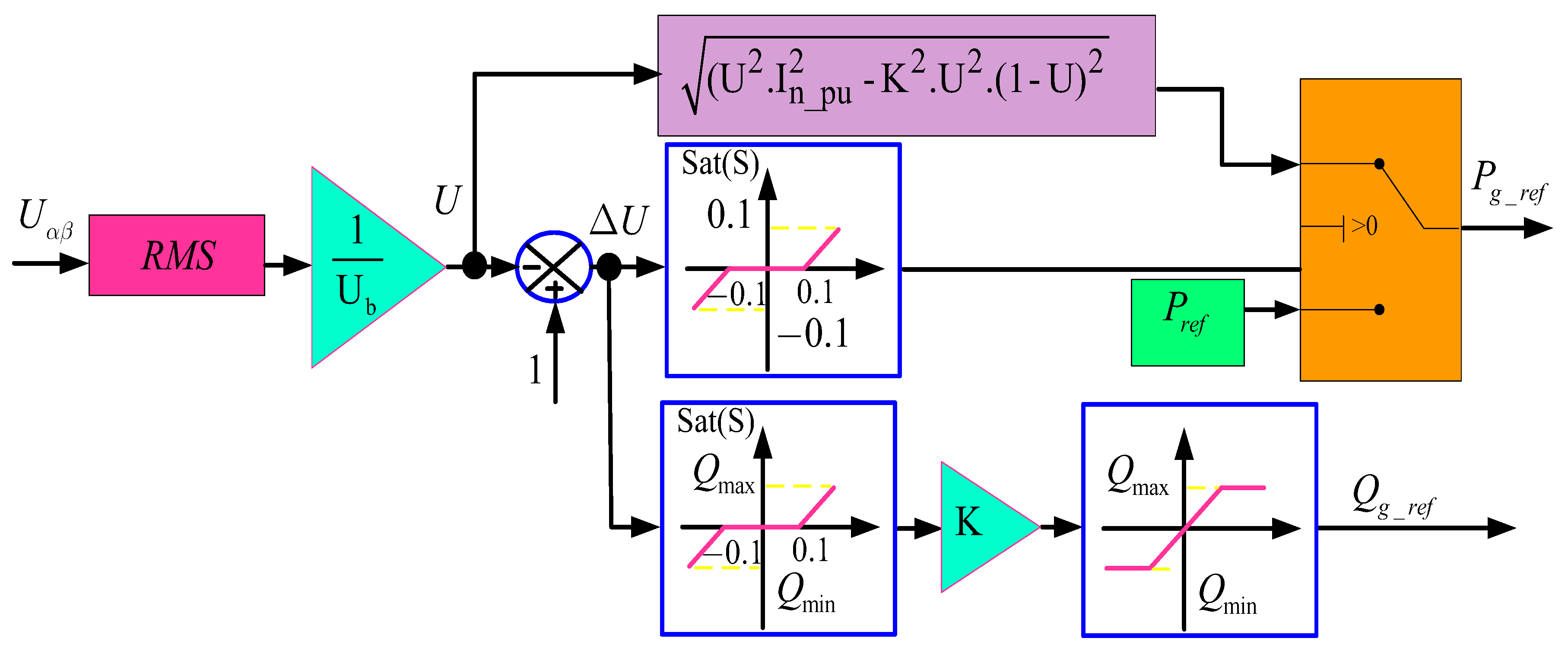



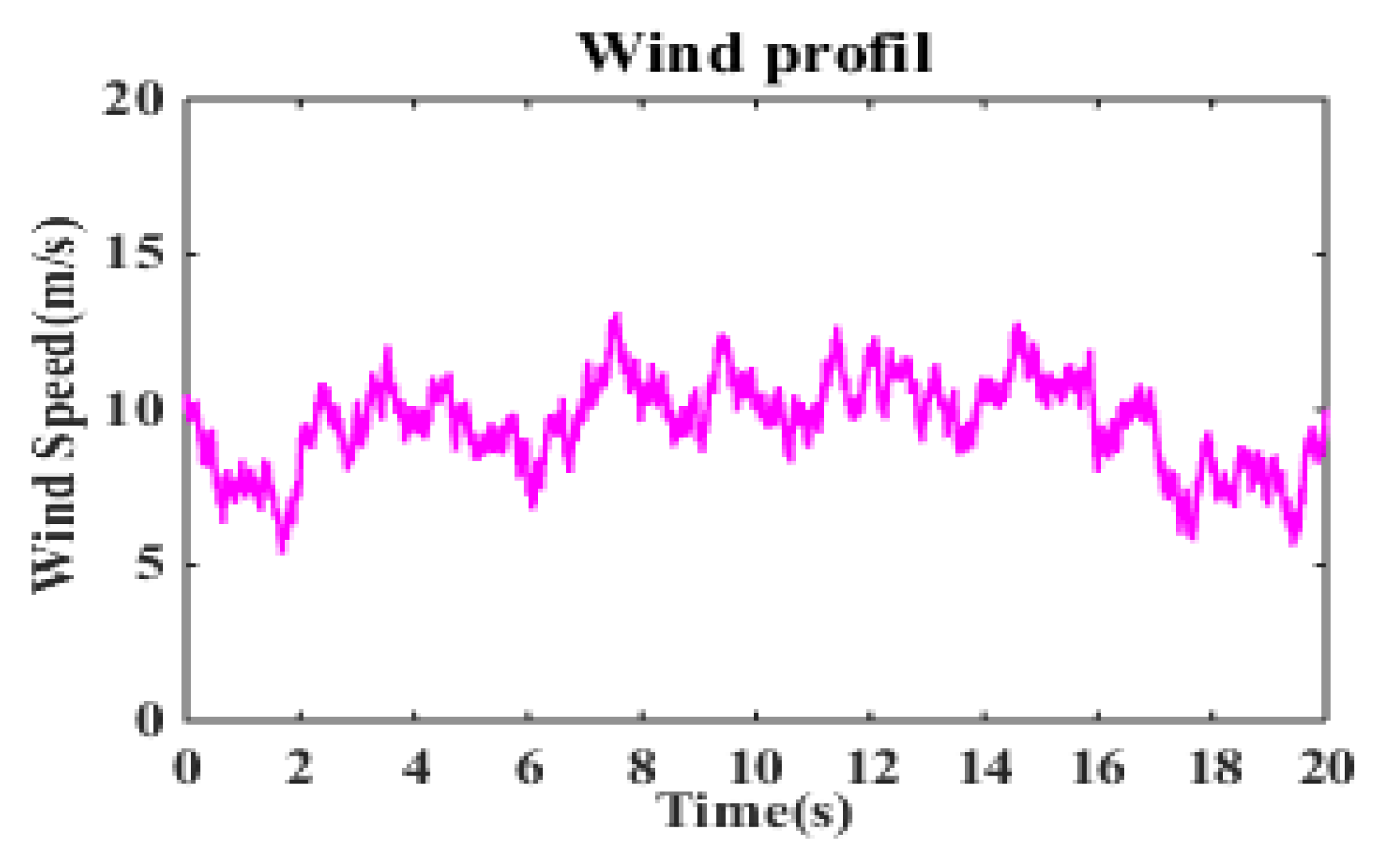
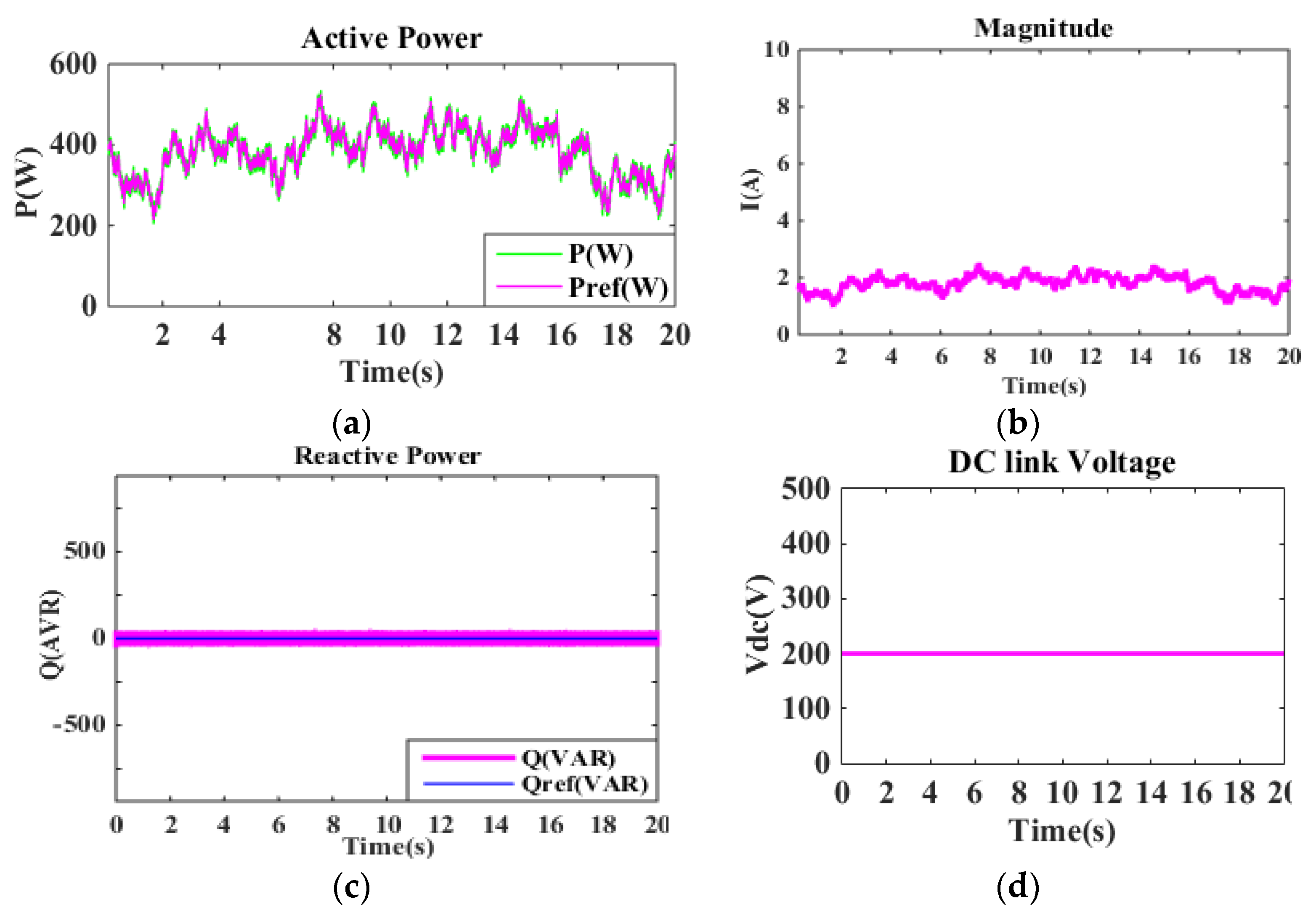
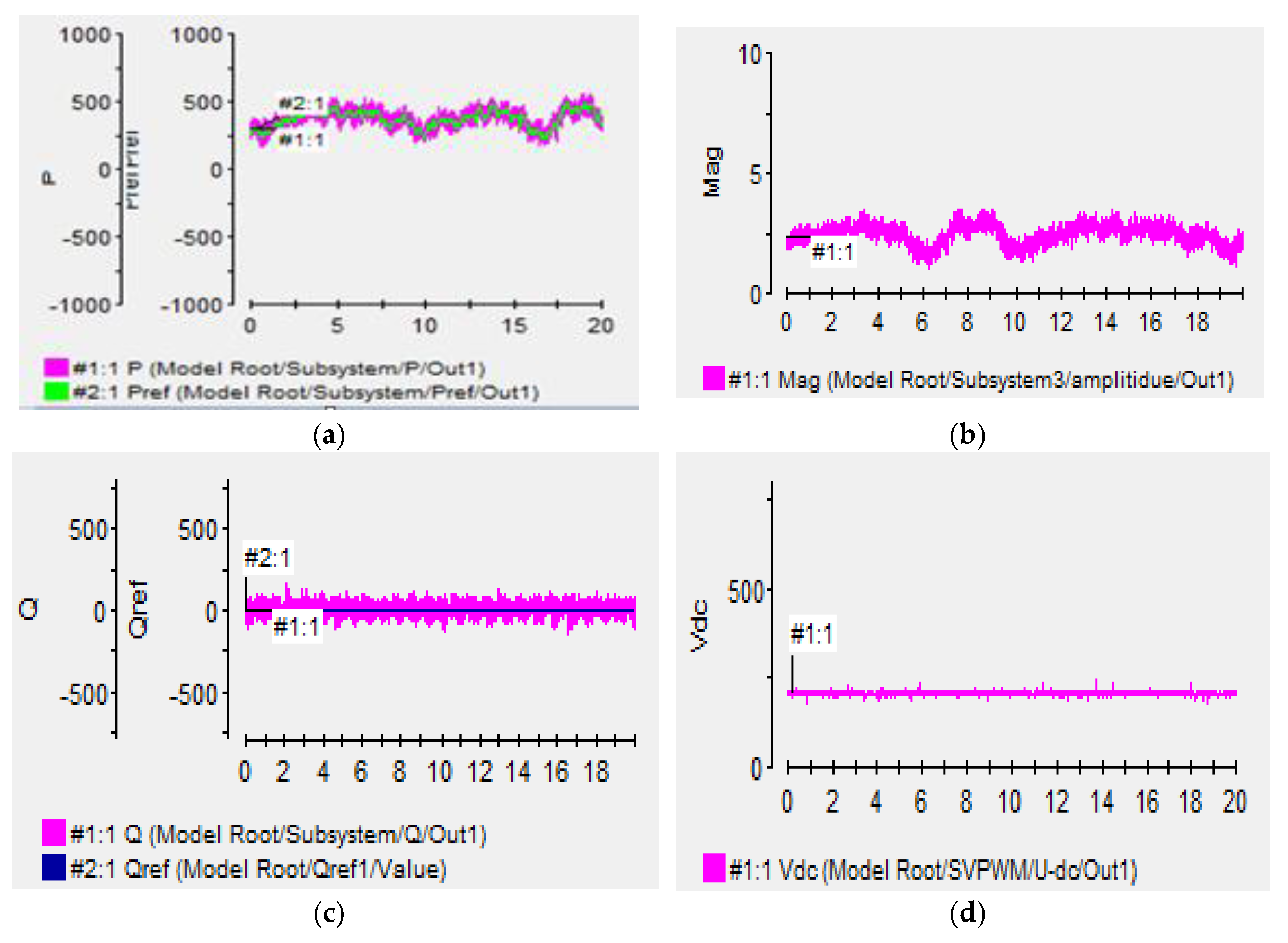
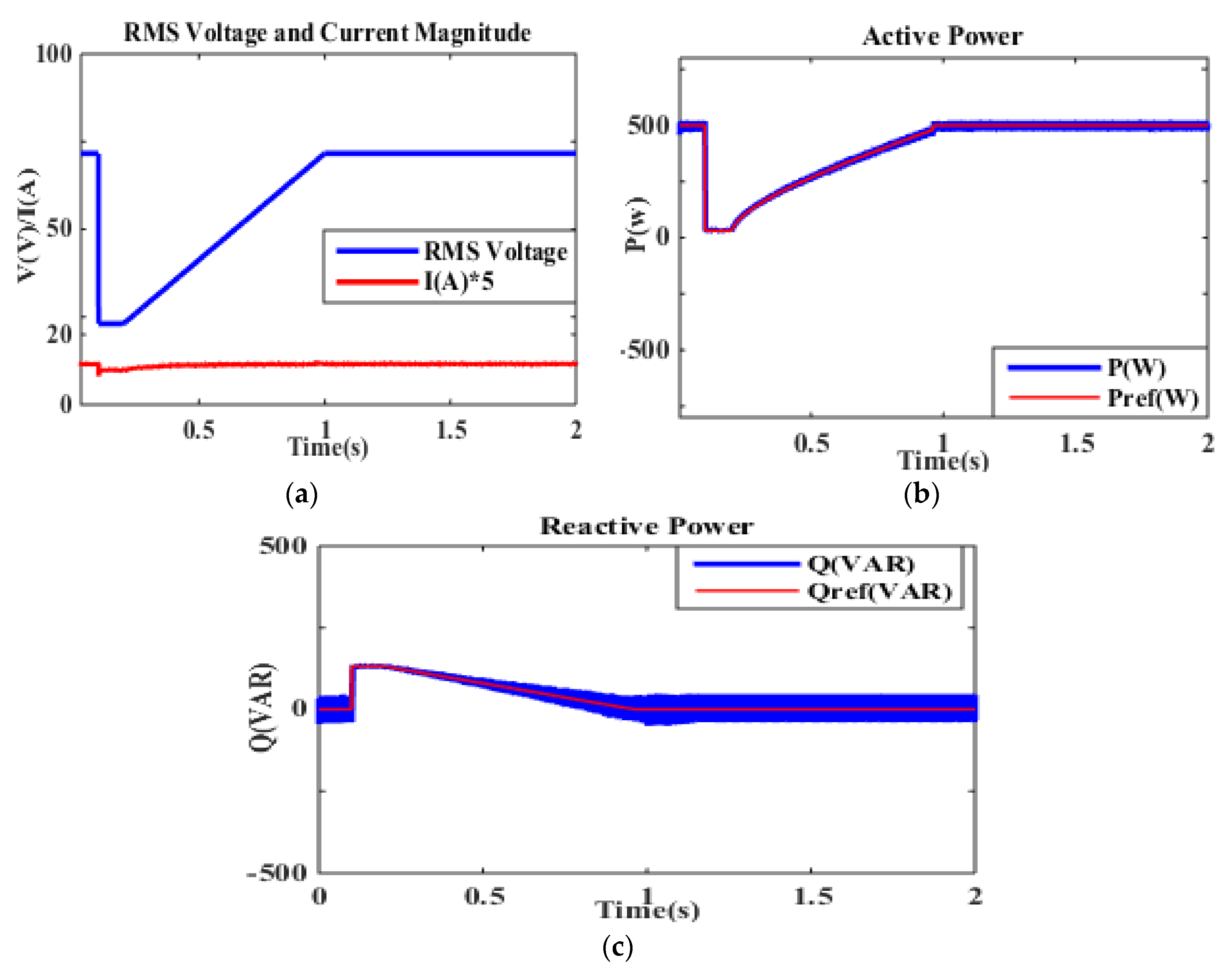
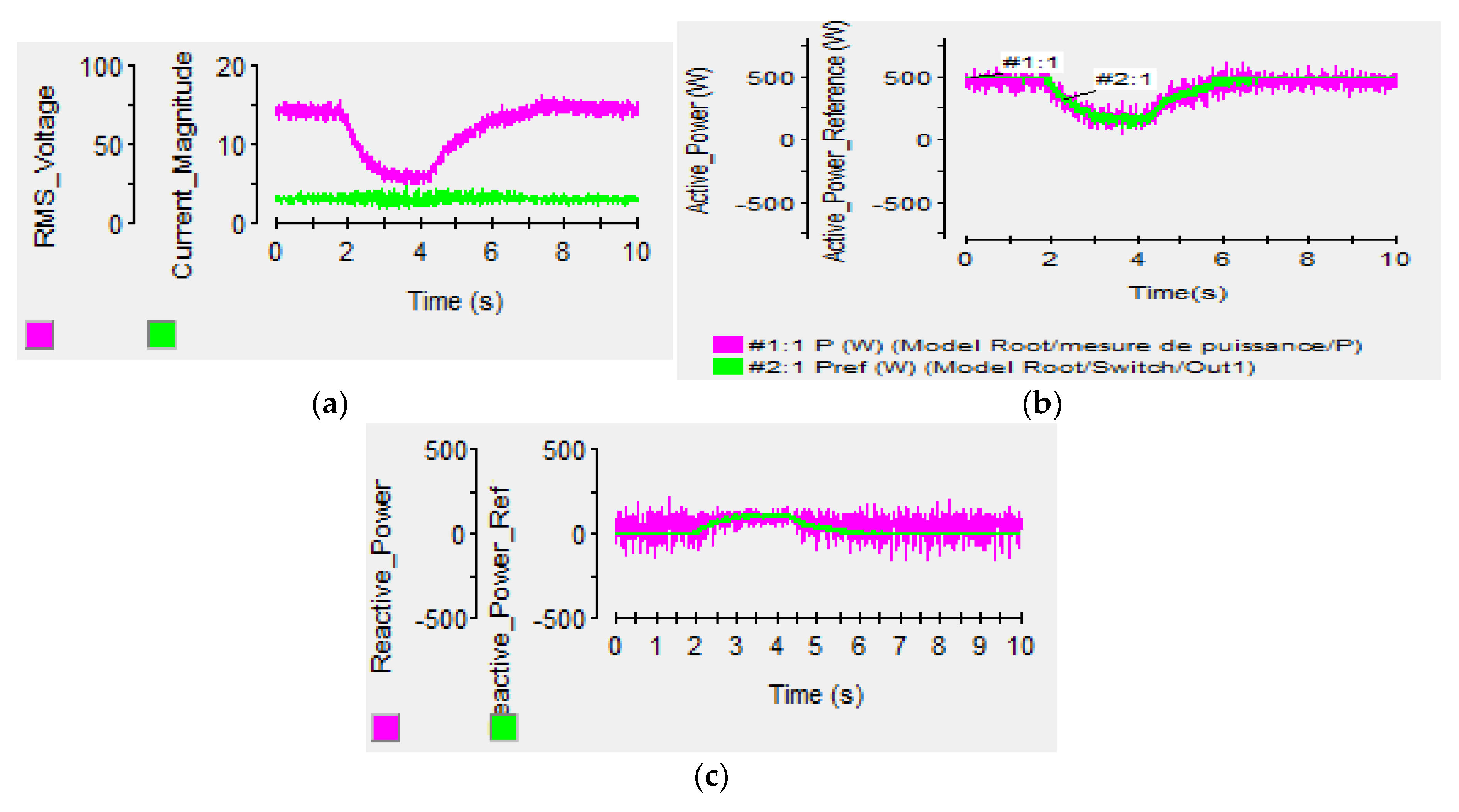
| Characteristic | Value |
|---|---|
| Blade radius R | 1.02 m |
| J | 7.2 Kg·m |
| F | 0.0018 N·m/s |
| Vw | 12 m/s |
| Characteristic | Value |
|---|---|
| Rated power | 1570 W |
| Ld = Lq | 3.9 mH |
| Rs | 0.5 Ω |
| p | 4 |
| F | 400 Hz |
| Characteristic | Value |
|---|---|
| Rated power | 500 W |
| U | 110 V |
| L, r | 12 mH, 0.6 Ω |
| Vdc | 200 V |
| F | 50 Hz |
| Characteristic | Value |
|---|---|
| Positive gains Kp KI | 2500 |
© 2018 by the authors. Licensee MDPI, Basel, Switzerland. This article is an open access article distributed under the terms and conditions of the Creative Commons Attribution (CC BY) license (http://creativecommons.org/licenses/by/4.0/).
Share and Cite
Zoghlami, M.; Kadri, A.; Bacha, F. Analysis and Application of the Sliding Mode Control Approach in the Variable-Wind Speed Conversion System for the Utility of Grid Connection. Energies 2018, 11, 720. https://doi.org/10.3390/en11040720
Zoghlami M, Kadri A, Bacha F. Analysis and Application of the Sliding Mode Control Approach in the Variable-Wind Speed Conversion System for the Utility of Grid Connection. Energies. 2018; 11(4):720. https://doi.org/10.3390/en11040720
Chicago/Turabian StyleZoghlami, Maha, Ameni Kadri, and Faouzi Bacha. 2018. "Analysis and Application of the Sliding Mode Control Approach in the Variable-Wind Speed Conversion System for the Utility of Grid Connection" Energies 11, no. 4: 720. https://doi.org/10.3390/en11040720
APA StyleZoghlami, M., Kadri, A., & Bacha, F. (2018). Analysis and Application of the Sliding Mode Control Approach in the Variable-Wind Speed Conversion System for the Utility of Grid Connection. Energies, 11(4), 720. https://doi.org/10.3390/en11040720





